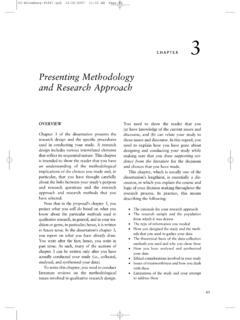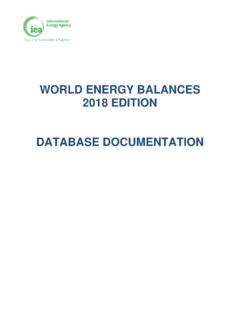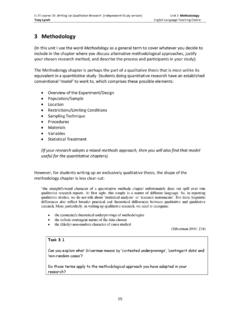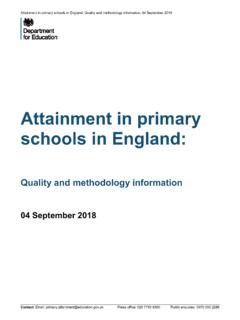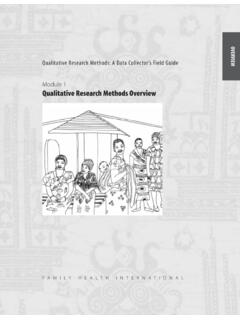Transcription of Principles of Survey Methodology - UCLA Labor Center
1 WINTER 2014 , UCLA Principles of Survey Met hodology Labor & Workplace Studies 188-3 and Chicano Studies 191-5 Applied Research Methods in the LA Labor Community Winter Quarter 2014 Outline 2 What is a Survey ? What is Survey Methodology ? Survey design Survey quali ty Ethical issues in using Survey Methodology What is a Survey ? 3 A systematic method for gathering information from (a sample of) individuals for the purposes of describi ng the attributes of the larger population of which the individuals are members. The attributes attempt to describe basic characteristics or experiences of large and small populations in our wor ld. (Enanoria, 2005) Features of a Survey 4 Information is gathered by asking people questions Information is collected either by having interviewers ask questions and record answers or by having people read or hear questions and record their answers Information is collected from only a subset of the population to be described (a sample) rather than from all members (Groves, et al.)
2 , 2009) First questions to a sk about a new Survey 5 What is the target population (whom is it studying?) What is the sampling frame (how do they identify the people who have a chance to be included in the Survey )? What is the sample design (how do they select the respondents)? What is the mode of data collection (how do they collect data )? Is it an ongoing Survey or a one-time Survey ? The Survey proc ess (Hulley et al., 2007) 6 7 Elements o f s urvey research Element Purpose Research questions What questions will the study address? Background and significance Why are these questions important? Design Time frame Approach Subjects Selection criteria Sampling design Who are the subjects and how will they be selected? Variables Predictor variables Confounding variables Outcome variables What measurements will be made?
3 Statistical issues Hypothesis Sample size Analytic approach How large is the study and how will it be analyzed? (Hulley et al., 2007) Research question 8 Research question = the objectiv e of the stu dy, the uncertainty the resear cher wants to resolv e. It often begins with a genera question and then is nar rowed down to become a specific, concrete, resear chable iss ue. Example resear ch question: Does publication pressure have an impact on the practice of science? Breaking down the question: How do scholars perceive the publish-or-perish culture? What are the perceived intended and unintended consequences? How do scholars perceive academic success? How do publication pressure affect the intrinsic rewards of the job? Background and significance 9 Sets the proposed stu dy in context and gives its rationale: What is known about the topic at hand?
4 Why is the rese ar ch questi on important? What kind of answers will the study provide? This section should: Cite previous rese ar ch that is relevant Indicate the problems with the prior rese ar ch and what uncertainties remain Specify how the fi ndings of the propose d study will help reso lve these uncertainties and lead to new scientifi c knowledge Design (Groves et al., 2009) 10 Design: constructs 11 Constructs: the elements of information that are sought by the researcher. In some sense, constructs are ideas Can be abstract Example: Perceived consequences of publication pressure Perception of determinants of academic success Design: measurement 12 Measurements are more concrete than constructs Ways to gather information about constructs Often the questions posed to a respondent, using words Critical task for measurement: Design questions that produce answers reflecting perfectly the constructs you are trying to measure Example of constr ucts and measur ements 13 Construct: Perceived Authoritative Advantage (The extent to which a biomedical scientist believes that publishing in an open access journal would enhance his or her authority) Publishing in an open access journal makes me more prestigious.
5 Publishing in an open access journal makes me more well-known. Publishing in an open access journal makes me more concept-marker. Publishing in an open access journal makes me nobler. Publishing in an open access journal improves my priority. Publishing in an open access journal makes me more trustworthy. Publishing in an open access journal makes me more credible. Publishing in an open access journal makes me more reliable. Publishing in an open access journal makes me more scholarly. Publishing in an open access journal makes me more authoritative by copyright Example of constructs and measur ements Survey Methodology , Wuhan University 6/22/12 14 Measurements: Publishing in an open access journal makes me more prestigious. Strongly agree agree neutral disagree Strongly disagree No opinion 5 4 3 2 1 N/A Design: response Survey Methodology , Wuhan University 6/22/12 15 The data pr oduced in a Survey come from information pr ovided through the Survey measurements Design: representation dimension Survey Methodology , Wuhan University 6/22/12 16 The target population , child ren and teenagers aged 6-18, households in China, persons with disabilities The frame population: The set of target popula tion members th at has a chance to be selected into the Survey sample , using to sample child ren and teenagers, using te lephone directory to select households The sample A sample is selected from a sampling frame.
6 The respondents Design: sampling 17 Sampling plan How an adequate sample size will be determined The choice of media through which the Survey will be administered Telephone interviews F-to -F interviews Mailed questionnaire Online questionnaire Procedures for obtaining population estimates from the sample data and for estimating the reliability of those population estimates Design: sample selection 18 Sample size is determined by: Desired degree of precision Statistical power required Ability of the researcher to gain access to the study subjects Degree to which the population can be stratifi ed Selection of the rele vant units of analysis Study design set s up inferences (Hulley et al., 2007) 19 Design: Survey instrument 20 Standards for good Survey questions Question wording Feasible and ethical Biased wording Biased context Types of Survey questions 21 Open-ended questions Closed-ended questions Questions that describe and evaluate people, places, and events Evaluativ e scales: usually 5-7 response options Agreement scales Other rat ing scales: importance (1st, 2nd, 3rd.)
7 Questions that measure responses to ideas, analyses or proposals Questions that measure knowle dge: familiarity with something Survey process (Groves et al., 2009) 22 Example: ARL Annual Salary Survey 23 org/stats/annualsurveys/ Cover letter to directors Instructions about data input Survey form data template ARL lib rary codes Standard for race and ethnici ty Survey Met hodology 24 QUALITY CONTROL A few important terms 25 Interviews: verbal surveys Questionnaire: written surveys Reliability: the consistency of Survey responses over time Item consistency: whether the responses for each question are consistent across constructs Test administration and scoring consistency: the pr obability of error s caused by carelessness in administration or scoring Important terms (cont d) 26 Vali dity.
8 The extent to which the measurements of the Survey provide the informati on needed to meet the study s purpose Content validity considers whether the questions measure the content they were intended to measure. Predictive validity examines whether the responses ar e able to predict a criterion measure. Concurrent validity addresses the correlation of Survey results with results from other sources. Construct validity asks whether the Survey questions capably measure hypothetical constructs. What is Survey met hodology 27 Survey Methodology is the study of Survey methods and the sources of error in surveys. Error describes deviations from the desired outcome Survey Methodology studies ways to minimize such errors. Survey quality perspecti ve (1) 28 Issues of measurement: Formulating questions Response order effects Bias in questionnaires Formatti ng the questionnaire Evaluating Survey questions Survey quality perspecti ve (2) 29 Implementing the study 30 Modes of administration Pilot studies Quali ty control Procedures data Post- collection of response data Ethical issues 31 Ethical issues in research involving human subjects 32 The Belmont Report Basic Ethical Principles : for persons - (1) do not harm and (2) maximize possible benefits and minimize possible harms fair pr ocedures and outcomes in the selection of research subjects federal policy for the protection of human subjects 33 Regulations for.
9 The defi niti on of rese ar ch IRB membersh ip IRB functions and operations IRB review of rese ar ch Criteria for IRB approval of rese ar ch IRB s authority to su spend or terminate approval of rese ar ch IRB records General requirements for informed consent Documentation of informed consent Definition of human subjects research as defined by federal policy 34 Research means a syste matic investigation, including re search development, te sting and evaluation, designed to develop or contribute to generalizable knowledge. Human subject means a living individual about whom an investigator (whether pr ofessional or stu dent) conducting re search obt ains (1) data through intervention or interaction with the individual, or (2) Identifiable private informati on.
10 IRB applicat ion content 35 Purpose of Research (Rationale or research question) Approach/Method What are you going to do and what is going to happen to the subject? Qualifications of the Researchers Characteristics of the Subject population to be Recruited Special Groups Involved in Research Type of Informed Consent to Be Obtained Precautions to Ensure Privacy and Confidentiality Risks to Subjects (physical, psychological, financial, etc.) and how the risks will be managed. Benefits to Subjects and Society at Large - How Do the Benefits Outweigh the Risks? All applications should be completed under the guidance of the student s faculty advisor and reviewed by the faculty advisor prior to submission. The application must be signed by the faculty advisor and the student . Informed consent 36 Require d elements include (are not limited to ): Statement that the study involves rese ar ch Purpose of Rese ar ch Procedures involved in the Rese ar ch Duration of Involvement in the Rese ar ch Participation is Voluntar y-Right to withdraw at anyti me without Penalty Right to confidentiality Risks and Benefits Who to Contact for More Informati on or Questi ons Who to Contact if a Participant is Harmed or Has Concerns Informed consent (cont d) 37 Use everyday language appropriate to potential participant (readable and clear) On institution s Letterhead Title of Research Si gnature lines References 38 Enanoria, W.

